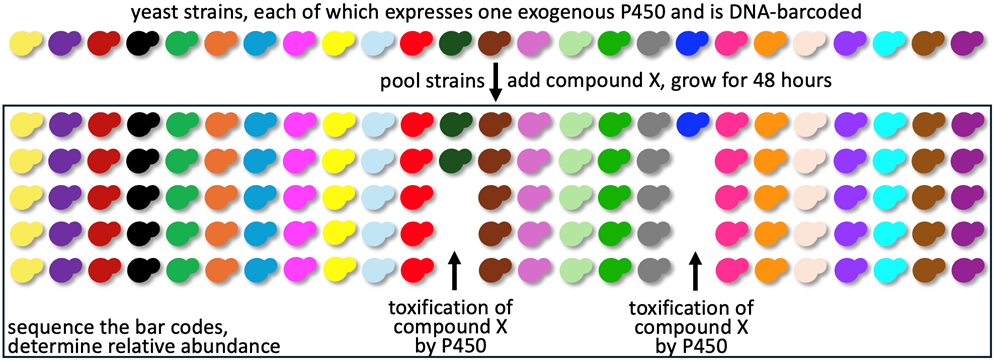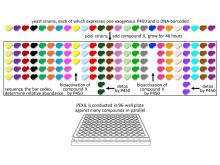BACKGROUND
The metabolic profiling of compounds is an essential step in any drug or agrochemical discovery effort. Key enzymes responsible for xenobiotic (drug, agrochemicals, pollutants) metabolism in humans are cytochrome P450s (P450s), which typically oxidize their substrates. The consequence of substrate oxidation is typically reduced efficacy, or more rarely, the generation of products with unwanted biological activity (aka toxification). Currently, testing whether pre-clinical or pre-market compounds are metabolized by P450s relies on incubating candidate compounds with purified P450s, enriched P450s (microsomes), or cultured hepatocytes and measuring the products using LC-MS/MS for metabolite profiling. Determining whether a compound is toxified by P450s typically relies on mammalian animal models. This is problematic for several reasons, including increasing regulation against using animal models, divergence of animal P450s from humans, and the expense and low throughput of current experimental approaches.
TECHNOLOGY
Researchers at the University of Toronto have developed a novel high-throughput assay called PEXIL (Paralleled screens for Enzyme-activated Xenobiotic-Induced Lethality) that reveals P450-mediated toxification of small molecules. PEXIL relies on a set of modified yeast strains, each of which is DNA-barcoded and expresses one heterologous P450 from an organism of interest. The strains are pooled, cultured in compound, and then the relative abundance of each strain is determined by measuring the abundance of DNA barcodes through sequencing. In this way, any P450 that toxifies the compound are revealed because the respective strain is less abundant within the pool. PEXIL is conducted in 96-well plates so as to allow the screening of many small molecules against many P450s in parallel.

Figure 1. The PEXIL assay reveals P450-mediated toxification. A set of yeast strains are engineered to individually express different P450s from an organizm and DNA-barcoding is used for identification. Changes in the fitness of the yeast is indicative of toxification.
COMPETITIVE ADVANTAGE
- High throughput
- Inexpensive
- Greater relevance because toxification by human P450s is directly measured (compared to animal models with divergent P450 sequence)
APPLICATIONS
- pre-clinical drug candidate toxification by human P450s
- pre-market pesticide toxification by human P450s
- agrochemical and industrial chemical toxification by human P450s
- pre-market cosmetic toxification by human P450s
- the development of pro-pesticides that are toxified by targeted pest
INTELLECTUAL PROPERTY STATUS
- US Application (May 2023)
PROJECT STATUS
- Proof-of-concept studies demonstrating high throughput and conversion of pesticides into toxic products by human P450s.
- Early-stage selective pro-insecticides developed
- Early-stage selective pro-nematicides developed
KEYWORDS
Drug metabolism, in vitro screening, human liver microsomes, recombinant enzymes, hepatocyte cultures, LC-MS/MS analysis, high-throughput screening (HTS), metabolic stability, bioactivation, enzyme kinetics, phase I metabolism, toxicity prediction, preclinical safety, pre-market safety, ADME (Absorption, Distribution, Metabolism, Excretion)





